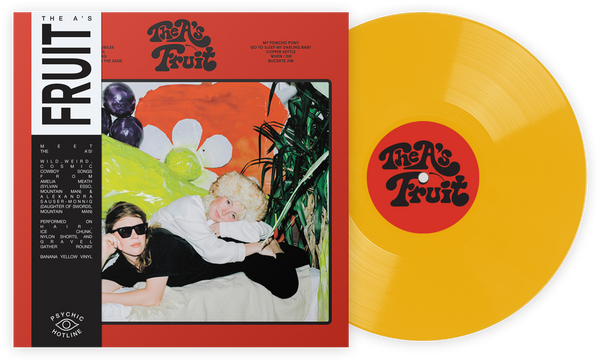Even though records are mass produced — not as bad as CDs, but mass produced nonetheless — there are still tiny, handcrafted elements to them. Many of us collectors enjoy the tactile experience that records provide. There’s a literal connection between music and listener there, but that’s not the only way that vinyl passes through hands. From the person running the press, to the QC tester, to the mastering engineer that cut the lacquer, to the technician that anodized that lacquer and began the process of turning it into a pressing plate, each one of those unsung heroes has had a direct influence on the sound of the albums we love.
While those people mostly remain anonymous, the journey of your record through various stages is actually contained in the space between the music, and the label, aka the “dead wax.” So now you’re thinking, wait. What? Yes, those letters and numbers in the dead wax on each of your records contains info that will allow you to determine any number of things.
The dead wax marking can be machine stamped, hand inscribed, or a mix thereof. What you’ll usually find may include a string of numbers and letters, a signature, and a symbol of some sort. What these inscriptions mean varies from record label to record label (and sometimes from pressing plant to pressing plant), but there are some commonalities. After you get your bearings, it’s possible to even make some educated guesses even if you don’t have all the info.
So What Sort of Story Are These Scribbles Telling Me Here?
This is the cool part. This is where you may find out that you won the first and/or rare pressing lottery. The long stream of numbers, sometimes prefaced by two or three-letter code, are typically a catalog number or part number identifying the stamper used. Essentially, this is your album’s ID. Immediately after this is commonly followed by a dash and a number/letter combination such as “-1A.” There is some variation on this, but typically this would indicate that the record is a first pressing and you’re looking at side A.
After the catalog/part and pressing information, you may see “RE” inscribed into the dead wax. This symbol indicates that the album is a repressing. Keep in mind that back when records were pretty much the only way to get music, albums were pressed by the millions regularly. So, repressings can still be from the year of the album’s release. A RE pressing may or may not be as collectable, but there’s still a good chance that it will have similar mastering and sound as an initial pressing.
Mastering is very much an art and, like a lot of artists, mastering engineers have been known to sign their work. The next inscription that you’ll probably see is the initials of that engineer. Other than checking to see if you have a first pressing, this is probably what you’ll most like to know about the record you’re holding. Each engineer has their own style, so if you find one that you like you should definitely learn their signature and keep an eye out for more. Some are easy to guess such as “RL” for Robert Ludwig, “MILES” for Miles Showell, and “KG” for Kevin Gray. Some are less so like “Pecko Duck,” the nom de plume of George Peckham.
Further down the dead wax rabbit hole there is typically some inscription that tells you where the record was pressed. Just like engineers have their reputations, so do pressing plants. Some use slightly different vinyl formulations than other plants use and may have higher QC standards as well. Some just have that undefinable mojo going for them. If you see, for instance a triangle with “IAM” written in it, that would be a Capitol pressing from Scranton. A horizontal line with a sideways triangle with its apex touching the line indicates the record is also Capitol, but was pressed at the Winchester plant. CT or CTH is Columbia Terra Haute. At one time, there were many pressing plants in the U.S. Now there are maybe thirty. So, when you’re decoding the dead wax of older albums, you may see a pretty wide variety of pressing plant inscriptions. Many albums had copies pressed at different locations to cut down on shipping times. This could explain why that cool Count Basie record you have sounds different than your friend’s copy of the same album.
Is There A Practical Use For This?
What? Trivia isn’t enough for you? Fair enough. The real benefit of cataloging dead wax inscriptions (also known as matrix numbers) is so that you can tailor your collection to your liking. If there is a mastering engineer or pressing plant that you like the sound of, this is how you ensure that you find what you’re looking for. Also, if someone is trying to sell you a first pressing and you’re just not quite sure what to look for, understanding what is in the dead wax will put you on your first step of authenticating or debunking the seller’s claims. If nothing else, you’ll look like a wizard to your friends as you hold a record up and proclaim its provenance.
Are There Other Things Hiding In The Dead Wax?
Tons! In addition to the above information, many artists have been known to sneak stuff in there. From Neil Young’s “Goodbye Waterface” in the dead wax of Tonight’s the Night to the messages found on every album Third Man Records has ever pressed, you can see little welcome notes from the people that brought you the music. Some are funny, some are weird, a few might be rude. It’s all part of the magic.
OK. This Was Pretty General. Do You Have Any Specific Examples?
I do!
Engineers:
MILES = Miles Showell
RL = Robert Ludwig
BG = Bernie Grundman
Pecko Duck = George Peckham
GC = Greg Calbi
Øphase = Ashley Burchett
Pressing Plants:
Symbol of a drum with two drumsticks = Artisan
PRC = PRC
SP = Specialty Records
Symbol of a “U” inside a circle = United Pressing
STERLING (stamped) = Sterling Sound
P USA = Pallas for US export.
CJ Hurtt is a record nerd and writer who lives in a remote fishing village in the Pacific Northwest. His work has appeared in Word Riot, various games for Aegis Studios, and Brain Scan Comics.
Related Articles
Join the Club!
Join Now, Starting at $44
Exclusive 15% Off for Teachers, Students, Military members, Healthcare professionals & First Responders - Get Verified!












